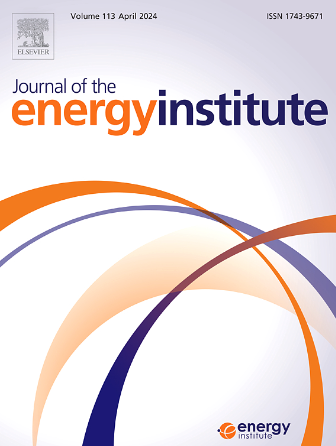Alternative Fe7C3/ZrO2 carbides for stable and selective olefins production via CO2-FT process: Co-operative effect of alkali-alkaline earth promoters
IF 5.6
2区 工程技术
Q2 ENERGY & FUELS
引用次数: 0
Abstract
Improved light olefins yield via catalytic CO2 conversions supports circular carbon economy and also addresses global climate change effects to some extent. Present work demonstrates stable orthorhombic Fe7C3 formation on commercial ZrO2 by using citric acid chelation method and its subsequent pretreatment under CO/H2(g) = 0.93 studied in CO2-FT process. For the first time, co-operative effect of alkaline earth promoters (AEP= Mg or Ca or Ba) with alkali metal (K) was investigated in detail on the extent of Fe0/Fe7C3 formation in FeZnK-AEP/ZrO2 catalysts. Significant enhancement in the textural properties and iron oxide reduction were found in K-AEP duo catalysts. Essentially, XRD and H2-TPD studies revealed improved metallic iron phase in Mg-K or Ca-K duo which resulted in greater light paraffins formation. However, Ba-K duo enhanced the carbidization of reduced iron species in the catalyst as established through Mossbauer data wherein FexCy/Fe3O4 ratio was 1.2 times higher than in reference FeZnK/ZrO2 catalyst. Among the K-AEP duos, the decreasing order of light olefins space time yield found as: FeZnK-Mg/ZrO2 (6.75 mmol gcat−1 h−1) < FeZnK/ZrO2 (7.39 mmol gcat−1 h−1) < FeZnK-Ca/ZrO2 (7.53 mmol gcat−1 h−1) < FeZnK-Ba/ZrO2 (9.01 mmol gcat−1 h−1). The greater light olefins yield was associated with surface enrichment of Fe-C species, optimized basicity and H2 activation on FeZnK-Ba/ZrO2 respectively noticed through XPS, CO2 and H2-TPD results. Therefore, FeZnK-Ba/ZrO2 with 20h of consistent activity can serve as an alternative catalyst with an alternative active phase of Fe7C3 in CO2-FT studies, unlike literature heavily loaded with Fe3C and Fe5C2 bulk active phases.

CO2-FT法稳定选择性生产烯烃的替代Fe7C3/ZrO2碳化物:碱-碱土促进剂的协同作用
通过催化CO2转化提高轻烯烃产量,支持了循环碳经济,也在一定程度上解决了全球气候变化的影响。在CO/H2(g) = 0.93的CO2-FT工艺条件下,柠檬酸螯合法在工业ZrO2上稳定生成正交Fe7C3。首次详细研究了碱土促进剂(AEP= Mg或Ca或Ba)与碱金属(K)的协同作用对FeZnK-AEP/ZrO2催化剂中Fe0/Fe7C3生成程度的影响。K-AEP双催化剂的结构性能和铁氧化物还原性能均有显著提高。XRD和H2-TPD研究表明,Mg-K或Ca-K二元结构中的金属铁相得到了改善,从而形成了更多的轻石蜡。然而,通过穆斯堡尔数据证实,Ba-K双组分增强了催化剂中还原铁的碳化,其中fexy /Fe3O4比参考FeZnK/ZrO2催化剂高1.2倍。在K-AEP体系中,轻烯烃时空产率的递减顺序为:FeZnK-Mg/ZrO2 (6.75 mmol gcat−1 h−1)<;FeZnK/ZrO2 (7.39 mmol gcat−1 h−1)<;FeZnK-Ca/ZrO2 (7.53 mmol gcat−1 h−1)<;FeZnK-Ba/ZrO2 (9.01 mmol gcat−1 h−1)。较高的轻烯烃产率与Fe-C的表面富集有关,通过XPS、CO2和H2- tpd分别观察到FeZnK-Ba/ZrO2的碱度和H2活化优化。因此,在CO2-FT研究中,具有20h一致活性的feznb - ba /ZrO2可以作为具有Fe7C3替代活性相的替代催化剂,而不像文献中大量负载Fe3C和Fe5C2散装活性相。
本文章由计算机程序翻译,如有差异,请以英文原文为准。
求助全文
约1分钟内获得全文
求助全文
来源期刊

Journal of The Energy Institute
工程技术-能源与燃料
CiteScore
10.60
自引率
5.30%
发文量
166
审稿时长
16 days
期刊介绍:
The Journal of the Energy Institute provides peer reviewed coverage of original high quality research on energy, engineering and technology.The coverage is broad and the main areas of interest include:
Combustion engineering and associated technologies; process heating; power generation; engines and propulsion; emissions and environmental pollution control; clean coal technologies; carbon abatement technologies
Emissions and environmental pollution control; safety and hazards;
Clean coal technologies; carbon abatement technologies, including carbon capture and storage, CCS;
Petroleum engineering and fuel quality, including storage and transport
Alternative energy sources; biomass utilisation and biomass conversion technologies; energy from waste, incineration and recycling
Energy conversion, energy recovery and energy efficiency; space heating, fuel cells, heat pumps and cooling systems
Energy storage
The journal''s coverage reflects changes in energy technology that result from the transition to more efficient energy production and end use together with reduced carbon emission.
 求助内容:
求助内容: 应助结果提醒方式:
应助结果提醒方式:


